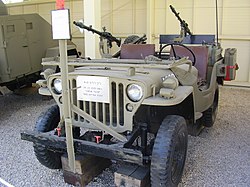Top Qs
Timeline
Chat
Perspective
Wire catcher
Protective device for personnel in military vehicles From Wikipedia, the free encyclopedia
Remove ads
A wire catcher (also known as Wire Cutter or Wire Anti-Decapitation Device) is a device used to protect military personnel in open vehicles against taut-wire traps.

Design
A wire catcher consists of a strip of angle iron bolted upright to the forward bumper of a jeep.[1][2][3] "It extends above the heads of those riding in the jeep, and is notched a few inches from the top so that any wire extending across the road will be caught and snipped."[1]
History
The first land vehicle wire cutter to be demonstrated was attached to a Killen-Strait tractor for the British in 1915. Two scissor-like Royal Navy torpedo net cutters were fitted to the front of the tractor at the end of two protruding shaped metal rods. The tractor was driven into a field of tensioned barbed wire that had been strung up at precisely the cutter's height. It was not effective with wire at different heights and was not put into service.[4] Heavy tanks were used simply to crush barbed wire obstacles instead.
During World War II, the Germans employed taut-wire traps strung across roadways designed to harm enemy soldiers riding in open vehicles such as jeeps and motorcycles.[5] Wire catchers were installed on jeeps as field modifications.[2][5]
Wire catchers were used up through the Vietnam War.[6]
Remove ads
Gallery
- 1942 Ford GPW with wire catcher
- 1944 Ford GPW with wire catcher
- Willys Jeep with wire catcher
- 1945 Willys MB Jeep with wire catcher
- Willys MB Jeep from the Samson's Foxes unit in the independence war (1948) with wire catcher
See also
- Rhino tank (with Culin hedgerow cutter)
- Wire strike protection system
References
Further reading
External links
Wikiwand - on
Seamless Wikipedia browsing. On steroids.
Remove ads





